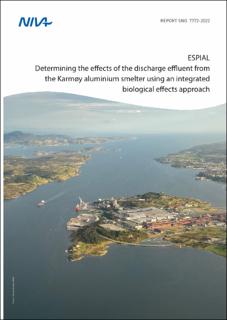| dc.contributor.author | Brooks, Steven | |
| dc.contributor.author | Gomes, Tania | |
| dc.contributor.author | Grung, Merete | |
| dc.contributor.author | Macken, Ailbhe | |
| dc.date.accessioned | 2022-10-20T09:24:34Z | |
| dc.date.available | 2022-10-20T09:24:34Z | |
| dc.date.created | 2022-10-17T14:09:31Z | |
| dc.date.issued | 2022 | |
| dc.identifier.isbn | 978-82-577-7508-7 | |
| dc.identifier.issn | 1894-7948 | |
| dc.identifier.uri | https://hdl.handle.net/11250/3027250 | |
| dc.description | Prosjektleder Ailbhe Macken | en_US |
| dc.description.abstract | The report describes a monitoring programme using field transplanted mussels to determine the potential biological effects of the effluent discharge from the Karmøy aluminium smelter operated by Hydro Aluminium in Norway. Chemical body burden (54 PAH and metal concentrations) and a suite of biological effects markers were measured in mussels positioned at known distances and at two depths from the aluminium smelters discharge for a period of 8 weeks. In addition, chemical concentrations of the sediment were also measured within the fjord to evaluate the impact of the aluminium smelter on the local marine environment. The highest PAH and metal contamination of the sediment was observed at station 4, a sheltered lagoon 1-1.5 km south of the smelter (Nordalsvågen), and also elevated at station 3, 500 m south of the smelter. PAH contamination in mussels at the closest stations to the aluminium smelter reflected the PAH profiles of the sediment concentrations at each station. This was not true for metals, which were relatively low in all mussels. The PAH concentration in mussels 2 m above the seafloor (bottom), were higher than mussels 5 m from the surface (top/surface) for three out of the four stations. Despite the accumulation of PAH in the mussels, the five biomarker responses were low and overall did not differentiate significantly between the mussel groups. The Principal Component Analysis (PCA) found no clear association between the impact of PAHs and metals with the biological responses in mussels, even in mussels placed closest to the aluminium smelter. | en_US |
| dc.description.sponsorship | Aluminiumindustriens Miljøsekretariat (AMS) | en_US |
| dc.language.iso | eng | en_US |
| dc.publisher | Norsk institutt for vannforskning | en_US |
| dc.relation.ispartof | NIVA-rapport | |
| dc.relation.ispartofseries | NIVA-rapport;7772-2022 | |
| dc.subject | Avløp | en_US |
| dc.subject | Effluent discharge | en_US |
| dc.subject | Biomarkører | en_US |
| dc.subject | Biomarkers | en_US |
| dc.subject | Smelteverk av aluminium | en_US |
| dc.subject | Aluminium smelter | en_US |
| dc.subject | PAH forurensning | en_US |
| dc.subject | PAH contamination | en_US |
| dc.title | Determining the effects of the discharge effluent from the Karmøy aluminium smelter using an integrated biological effects approach | en_US |
| dc.title.alternative | Determining the effects of the discharge effluent from the Karmøy aluminium smelter using an integrated biological effects approach | en_US |
| dc.type | Research report | en_US |
| dc.description.version | publishedVersion | en_US |
| dc.rights.holder | © Norsk institutt for vannforskning/Norwegian Institute for Water Research | en_US |
| dc.subject.nsi | VDP::Matematikk og naturvitenskap: 400 | en_US |
| dc.subject.nsi | VDP::Mathematics and natural scienses: 400 | en_US |
| dc.source.pagenumber | 62 | en_US |
| dc.source.issue | 7772-2022 | en_US |
| dc.identifier.cristin | 2062060 | |
| dc.relation.project | 180282 | en_US |
| cristin.ispublished | true | |
| cristin.fulltext | original | |
